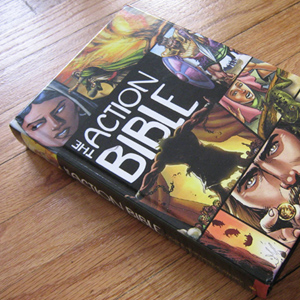
Pussy, twat, beaver, snatch, slit, quim, love rug, crotch, crack, mound, peach, yoni, minge – just a few of the less than lovely euphemisms listed by Emma Rees in her exhaustive study, The Vagina: A Literary and Cultural History. She has even been guilty of a euphemism herself, she confesses disarmingly, since the vagina is just one part of our genitals. The only word to encompass the whole package is that most taboo of all words, the worst insult you can throw, the most degrading of epithets. And what interests Rees is the connection, or sometimes disconnection, between a woman’s cunt and the woman herself. After all, if the mere word provokes such revulsion, how much is that a reflection of a deeper horror – of not just the offensive organs but their unfortunate bearers?
And there’s no better example of that connection than – well – religion. Over the next few weeks little children all over the country will be donning their angel wings, brandishing their shepherds’ crooks and making golden crowns for kings in imitation of the holy nativity. All the tinsel and paper chains, the carols, cards, turkey with trimmings and bulging mountains of wrapping paper are in honour of that most powerful of myths: the virgin birth.
For in order to be the carrier of God’s son, Mary had to be perfect, innocent and without blemish. That, of course, meant that she must conceive without sin – without sex and therefore without the defilement of penetration. Instead, the ghost came and planted seed in her ear. Which meant that she could remain a virgin. More perplexing, though, as Marina Warner pointed out in her 1976 study of Mary, Alone of All Her Sex, is that for early theologians she was required to remain a virgin post partum as well. Quite how the baby Jesus could have emerged without enlisting that troublesome organ remains a puzzle. But no matter how it was managed, the import of Mary’s virginity is clear: in order to remain pure, she must be free of the trappings of female sexuality. “The foundations of the ethic of sexual chastity,” Warner comments, “are laid in fear and loathing of the female body’s functions, in identification of evil with the flesh and flesh with woman.”
This fear and loathing, according to Sigmund Freud, stems from one universal condition: the terror of castration. A boy will assume that his mother once had a penis that is now absent, and that the vagina is the result of its removal. Man’s painful dilemma is that he constantly desires to enter the place of danger, but at the same time fears being engulfed, swallowed, lost in it. And the danger is made explicit in the ubiquitous presence in so many stories and images of the vagina dentata – the vagina with teeth. This myth, Rees argues, “has served universally for millennia to perpetuate a morbid fear of women’s genitals.” The threat of castration, she continues, “can be used to justify the maiming of women’s bodies, and the primitive legend of the vagina dentata – the toothed vagina – still functions to legitimise, or even to promote, misogynist practices such as female genital mutilation.”
Despite her obvious concerns about this practice, Rees does recoil from actually condemning it. “Who has the right to say that one culture’s traditions are wrong,” she demands, “and another’s are ‘right’?” This regrettable tendency towards cultural relativism also distorts her categorisation of the ways in which the cunt is celebrated – and denigrated – in the arts. Because she makes no distinction between major artists and lesser ones, while inexplicably omitting some leading figures, the result is too often confusing. Why, for example, feature authors like Kathy Acker and Maureen Freely, but not DH Lawrence, Henry Miller or Anaïs Nin? And in the visual arts, there’s not even a mention of Tracey Emin.
Even so, it is instructive to discover just how many artists have sought to reconstruct and to celebrate their genitals: Hannah Wilkes, who sculpted disembodied vulvas out of chewing-gum and attached them to herself; Harmony Hammond’s pinky-gold sculpted vulvas, complete with tiny wings; Julia Kunin’s Crimson Blossom, reworking the labia as a butterfly.
Such manifestations, Rees explains, were inspired by one ground-breaking piece: Judy Chicago’s The Dinner Party. A reclamation of both the word cunt and its real meaning, this majestic installation consists of a gigantic triangular table on which each place setting, commemorating a famous woman, represents a vulva, the plates and mats fashioned from traditional female crafts like textiles and ceramics.
While The Dinner Party electrified the art world in the 1970s, its ambition was echoed in this country by Germaine Greer’s rallying cry to women, The Female Eunuch. “Women,” she announced, “must first of all inform themselves about their own bodies, take over the study of gynaecology and obstetrics,” in order to find ourselves less disgusting. “Part of the modesty about the female genitalia stems from actual distaste,” Greer continued. “The worst name anyone can be called is cunt. The best thing a cunt can be is small and unobtrusive: the anxiety about the bigness of the penis is only equalled by anxiety about the smallness of the cunt. No woman wants to find out that she has a twat like a horse-collar.” It was those exhortations that inspired so many of us, in the early years of the women’s movement, to rather self-consciously sit round with mirrors intent on viewing and then learning to love our secret places. Rees reminds us that Greer continued her campaign in a BBC programme in 2006, in which she painted a huge orange-red word “cunt” on to a whitewashed wall. She wanted to restore the word to its proper meaning because, she said, the word vagina, in its omission of “all the bits that make it fun”, was offensive. And she liked the sound of the word, too. “Cunt,” asserted Greer, “demands to be taken seriously.”
Another celebrated attempt to rehabilitate the word was made by Eve Ensler in her Vagina Monologues, in which a team of female actors deliver paeans to the cunt. Ensler, like Rees, acknowledged that she would have preferred to use the more accurate word. Nonetheless, the pinnacle of the play is the moment when the entire audience is encouraged to shout the word loudly and joyously, and to use it afterwards whenever possible.
A more recent attempt at reclassification came last year from Naomi Wolf, who, in Vagina: A New Biography, argues for the central role of vagina in women’s sexual experiences. And in doing so she challenges the more traditional feminist view that it’s the clitoris that really counts. Connecting somewhat florid accounts of her own sexual awakening with interpretations of findings from neuroscience, Wolf claims to have identified a “profound brain-vagina connection” which is the source not just of sexual pleasure but of creativity, assertiveness and power.
But, Rees ruefully concludes, none of these efforts to decriminalise our sexuality has really worked, while the word cunt itself remains tenaciously taboo. And one reason, I think, is that the cunt – both it its real sense and as a swear word – is irredeemably funny.
Rees examines two examples of television comedies where not only do vaginas bite, engulf and swallow. They actually talk. And have mood swings. In Sex and the City, Charlotte is told by her gynaecologist that her vagina is depressed – leading to much hilarity among the girls when they meet for coffee. While Rees finds this episode lamentably lacking in sexual politics, she’s even more damning in her analysis of an episode of the surrealist cartoon series South Park. A drug-addicted towel pretends to be a real person in order to publicise its autobiography on The Oprah Show. And Oprah is shown to have not just a talking cunt but a talking bottom as well. This, Rees demonstrates, is a deeply troubling example of that show’s tendency to degrade and marginalise women.
But in her earnest textual deconstructions, Rees somehow fails to acknowledge quite how hilarious these conceits are, simply by giving voice and personality to a part of the body that has for centuries been regarded with such opprobrium. Moreover, while laughing at the breaking of the taboo, women viewers are also laughing at themselves. We’re supposed to love our cunts, but I’m afraid we often, guiltily, just find them rather funny.
The very word cunt is funny, too. Last year in a memorable gaffe, poor James Naughtie of BBC Radio 4’s Today programme misintroduced the then Minister of Culture, Jeremy Hunt. That slip has haunted him ever since. Every time the clip is gleefully replayed, the whole nation guffaws.
Maybe humour will always beat principle. Especially as jokes can sometimes serve to expose the complexity of our reactions to a simple word:
A man going into a brothel is confronted by a series of doors inviting him to state his preferences: “Blonde or brunette?” He walks through the blonde door. “Big tits or small tits?” Excitedly he chooses Big. “Hard cunt or soft cunt?” Soft cunt, he pants. And finds himself ejected on to the pavement.
Both The Vagina: A Literary and Cultural History (Bloomsbury) and Vagina: A New Biography (Virago) are available now

